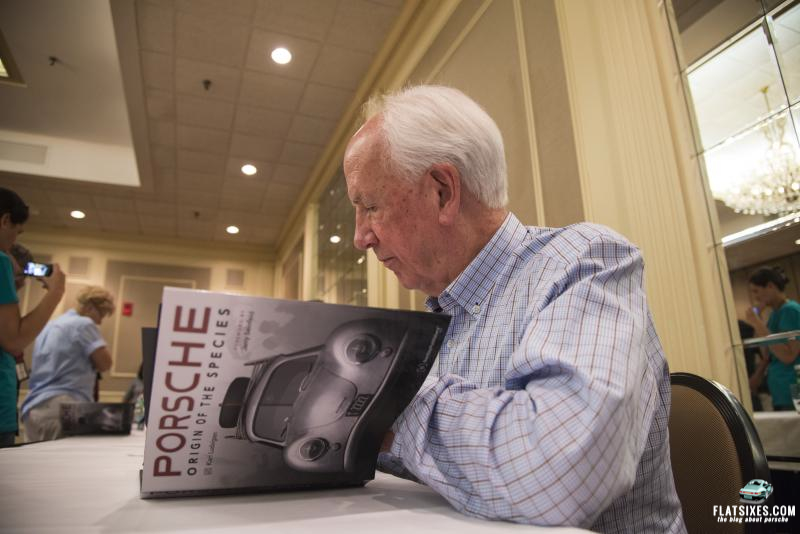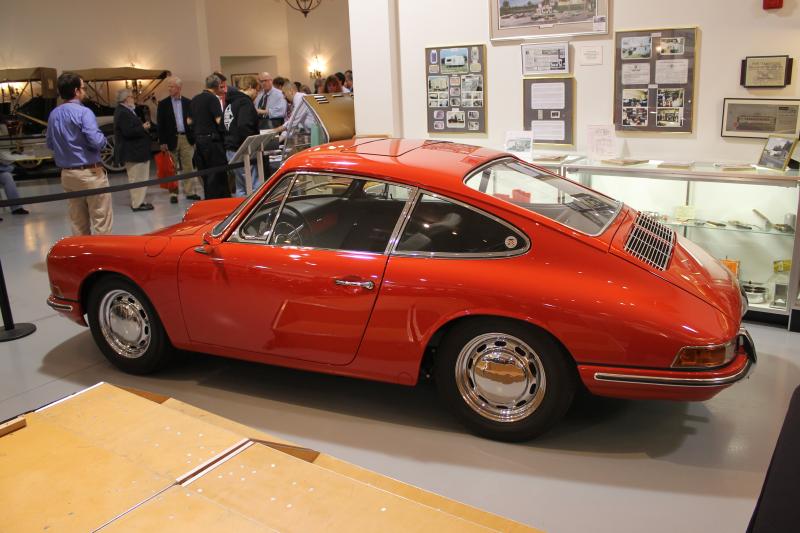There is likely nobody more knowledgeable in regard to the historically relevant moments of Porsche than Mr. Karl Ludvigsen. Having spent several years of his life chronicling these moments in the form of several literary works, from the beginnings-to-present historical epic “Excellence Was Expected”, to the most recent “Porsche – Origin of the Species” depicting the details of the Gmund-built 356 models, from how they came about, to how they changed the future of the company. Ludvigsen’s familiarity with Porsche factory employees, and members of the family, as well as his familiarity with the products that the company has churned out over its history has given him an opportunity to tell these stories to the rest of the world. Read our full account of the evening after the picture gallery below.

When the Antique Automobile Club of America Museum invited FLATSIXES.com to view their Porsche: Style & Design exhibit in conjunction with an evening speech given by Mr. Ludvigsen, we couldn’t have said yes any faster. A museum filled with Porsches, some excellent German food, and a speech by one of the most enlightened Porsche scholars, along with some socialization time with our fellow Porsche fanatics all added up to an evening that we’ll will not soon forget.
The Drive Was Long But Worth It
The evening opened with a torrential downpour beating down upon us from the heavens. My drive to Hershey, PA was arduous, but totally worth it. A six hour trek to see the museum, with the added benefit of being in town for the All Porsche Swap Meet the following Saturday, made for an excellent weekend. As I entered the main lobby, I was greeted by a 914 once, albeit briefly, owned by a personal favorite of mine, Mark Donohue, an absolutely pristine 356 Speedster, a very well done early 911 RSR replica, a right-hand-drive Red on Black 1973 2.7 Carrera RS Touring, and a very special Porsche-powered Royale Grand Touring Prototype.
A quick trip around the museum showed several different eras in the development of internal combustion transportation. Most closely related to my interests, we began with a 1947 KDF Volkswagen “Beetle” Split-Window coupe. The perfectness of this vehicle was eye catching and startling at the same time. Next on the list was a 356 Carrera GS Sunroof Coupe in similarly gorgeous condition. The twin-cam Porsche was near original, down to the period fog lamps, side window deflectors, and fitted luggage.
In the next room, I was shocked to see a perfect long-hood 911T, another gorgeous 2.7 Carrera )this one in iconic blue on white), a pristine 959, and the aborted 1980 Porsche/Interscope Racing Indycar project. While I am a fan of the other three Porsches, given my affinity for the car and racing history in general, I couldn’t help but be captivated by the open-wheel project. I pored over that particular Porsche for the better part of an hour, finding interest in the comparatively rudimentary aerodynamics, and the rear hanging turbocharger placement, driver amenities, and the H-pattern gearbox.
The main room of the exhibit housed a 914-6 GT, a Porsche Tractor, one of the dozen or so original pre-production 902 prototypes, an Elva-Porsche sports racer, a RSK racer once driven by one of the famous Rodriguez brothers, a 924 Carrera GTS Klub Sport, a very low mileage 968 coupe, a 1977 3.0 liter 930, and a 356C Carrera 2 cabriolet. The fact that I had already seen four Porsches with Fuhrmann-designed twin-cam engines was not beyond me, and one that I held close at hand.
A 901 Amongst Us
The piece de resistance, however, resided temporarily in the basement of the building, flanking the left hand side of the makeshift stage for the evening’s presentation. On the right of the stage, again surprisingly pristine, was a rare 1955 Continental Bent-Window Coupe. While the Continental was the first I had seen in the flesh, and was a truly eye-opening experience, it was completely eclipsed in my eyes by the four-wheeled beauty with which it shared the floor. To the left of the stage sat the true star of the collection, a 1963 901 prototype. While it was undeniably a 911, there were so many details separating it from series production, that it had a completely different visual feel. The forward-tilting manual wound sunroof, the round fuel filler lid, the dashboard, gauges, and steering wheel, among other details, set this 901 apart from the rest as truly unique. I was lucky to have viewed it.

As the evening’s speech began, I reflected upon the opportunity at which I was presented. I have looked up to Ludvigsen as a writer for many years, having used his books as reference material for my own writing and at least a dozen of his titles have been among my personal library over the years. Though we both spent the formative years of our lives in Kalamazoo, Michigan, Mr. Ludvigsen had many years of excellent and exciting experiences garnered before I was born. The following two hours of listening and speaking with Karl were great opportunities to learn, and I was not about to let this go to waste.
The speech, excellent though it was, left me yearning for more.
While I have spent some time reading about the formative years of the Porsche company that we all know and love, I have not had the in-depth opportunities to learn the truth that Karl has. The majority of Karl’s insightful facts and figures have come straight from the horse’s mouth, having garnered war-time and post-war project information directly from members of the Porsche and Piech families. From the design influences that shaped the iconic 356 body, to the engineering feats required to produce the first run of cars at the Gmund sawmill facility, to the financial concerns that led to their production, Karl discussed a little bit of each. Though Karl spoke for just over an hour, he only skimmed the surface of the story, presented in full in his new book “Origin of the Species”.
A Short Interview With Karl Ludvigsen
After a brief period of book signings and hand shakings, I was afforded the opportunity to speak with Karl on a one-to-one basis. I will share some of our conversation here for your enjoyment.
FLATSIXES: You have to have spent a lot of time in the Porsche archives to have garnered this kind of information. Could you touch on that?
Karl Ludvigsen: Yes, I have, but when I did the first book [Ed. Note: Excellence Was Expected, 1977] there were no archives, as such. They kind of let me loose in Huschke [Von Hanstein]’s office, and there were files and lists, and I got them all out and copied and made notes from them. There were bits and pieces from that, but I also conducted some good interviews with Helmuth Bott, Ferry Porsche, and others.
One of the things that I wanted to ask Ferry Porsche was “when did you decide that you wanted to build your own sportscars?” He had said that it was before the war, and at the time they had drawn a proposal for a 5-cylinder car. So I went back to their 10 jahre berichte (10 year reports) files and that was where I started. I’m not sure if you are interested in any of this, but that’s how it went.
FS: Well, to be honest, I’m interested in all of it. Excellence Was Expected is probably the most used book on my shelf, and I am constantly reaching for it to find a fact or check that something is correct. In fact, the only downfall of your book is that I often find myself continuing to read further than I had intended to research, which always puts me behind schedule!
KL: Good, that’s good. I’ve sucked you in. The one thing that I always wanted to do was to tell a good story. The biggest problem that I had with the first edition was that the editor would kill my punchlines. I tried to end each chapter with a little hanging suspense note to make the reader think “ooh, maybe I’d better read the next chapter.”, but he took all of that stuff out. That is why I was thrilled to do the new book for Bentley, and fix all of that. I went back to the original copies of my original text, and I fixed all of them.
FS: It seems that every day there is more knowledge that has just become “public”. People can find facts on the internet somewhere. Going forward, what do you think the role of an automotive historian is going to be? Is it simply going to be compiling at that point?
KL: I don’t think so. My view on that is different. My mission is to explain to people not only what happened, but why and how things happened. We know what Porsche did, but we don’t always know why they did it. I think that is what makes my books valuable, it speaks to why. What they didn’t do is equally as interesting to me as what they did do. I try to convey a feeling of who these guys are.
FS: Since the rewrite of Excellence Was Expected came out in 2008, Porsche has since formed into a new company, or a different company. With that in mind, how long are we going to have to wait for a third version of the book to come out?
KL: Not long. I mean, I’m under such pressure from Bentley to add new information, and we’ll probably get something new out pretty darn soon.
FS: Well, I certainly look forward to it. I have one last question before I let you go. Of the entire history of Porsche, what do you think is the most significant moment?
KL: Well, I would probably say that it was the moment they decided to continue building cars after they moved back to Stuttgart from Gmund, because it could have gone the other way. That was a big, big moment.
FS: I’ll take that answer, that’s a good answer. Well, I genuinely appreciate your time, and I’ll let you go about your day.
FLATSIXES.COM would like to extend our gratitude and say thank you to the AACA Museum for their hospitality, Bentley Publishing for facilitating the event and letting Karl tell us his stories, and of course, Mr. Ludvigsen himself for taking the time to tell these stories. It was an excellent event, and we are ecstatic to have been a part of it.
Other Porsche Blog Porsche You Will Enjoy
Interview with Karl Ludvigsen on Porsche: Excellence was Expected
Book Review: White Racers from Zuffenhausen by Karl Ludvigsen
Karl Ludvigsen: Porsche Spyders 1956-1964
Interview with Randy Leffingwell: noted Porsche author and photographer